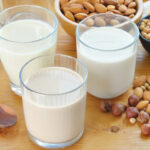1. Oat Milk – Not Dairy, But “Starch Milk”
Despite its name, oat milk is predominantly a carbohydrate-based product, containing no animal milk. Every 300ml serving is equivalent to 0.4 bowls of rice in starch content, and a large oat milk latte can amount to half a bowl of rice. Excessive consumption can lead to high blood sugar and weight gain, especially when it contains added oil and fat. Recommendation: Opt for unsweetened varieties with minimal additives and a protein content of >1g/100ml, and pair it with protein- and calcium-rich foods for nutritional balance.

2. Energy Bars – Deceptively High in Sugar
Many people consume oatmeal bars, often during workouts, believing them to be healthy. However, flavors like caramel, chocolate, and yogurt can contain up to 20-30% refined sugar, despite being marketed as “unsweetened.” Recommendation: Choose energy bars with natural ingredients (seeds, dried fruit, oatmeal), less than 10g of sugar/bar, minimal oil, and ideally, 15g of protein.
3. Breakfast Cereals – Loaded with Sugar and Cream
Some breakfast cereals on the market are laden with added sugar, cream, or milk powder, resulting in excessive fat and calorie content. Recommendation: Opt for unsweetened, whole grain varieties and pair them with fresh milk, unsweetened soy milk, or plain yogurt. Enhance the nutritional profile by adding fresh fruit like kiwi for a boost of vitamin C and fiber.

4. Wholemeal Bread – Not Necessarily Low in Fat
Wholemeal bread isn’t always a healthier choice than white bread. Many commercial varieties are made with added sugar and oil to enhance their flavor, resulting in a higher energy content. Recommendation: Choose breads with a coarse texture and less elasticity, indicating a higher whole grain content. Pair it with vegetables and protein-rich foods for a balanced meal.
“The Secret to Golden, Crispy Fried Wings”
Recently, a new trend has taken the culinary world by storm, especially among food enthusiasts and home cooks. Instead of using the traditional method of coloring and sweetening dishes with refined sugar, a secret ingredient is being whispered among the culinary community – a mysterious fruit that transforms dishes into a masterpiece of flavor and aesthetics. With its natural sweetness and vibrant hues, this fruit elevates the taste and appearance of meat and fish dishes to new heights, taking your culinary creations to the level of a gourmet chef.
Can You Eat Fruit Instead of Vegetables?
A common misconception among consumers is that it is acceptable to forgo vegetables in their diet as long as they consume fruits, or that fruits can entirely replace vegetables. However, it is important to note that solely relying on fruits as a replacement for vegetables in one’s diet is not advisable.






































